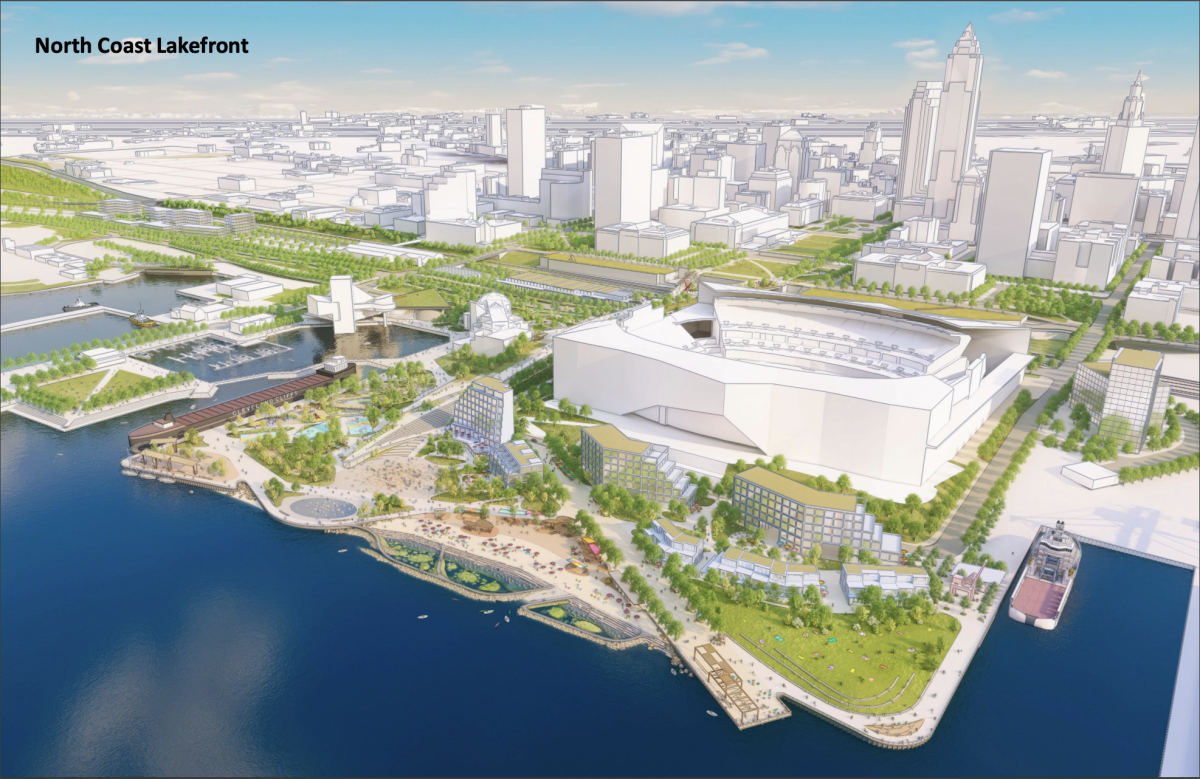The City of Cleveland recently unveiled a new layout for the reconstruction of the Lake Erie waterfront. The latest plans, publicly released in July, included the announcement of a team of architects and planners in collaboration to carry out the reconstruction of the lakefront.
The development of the lakefront includes a variety of new amenities and recreational spaces for public use. The preview of the layout includes a large apartment complex on the waterfront, a 1,100-seat amphitheater, a transit station for Amtrak, Greyhound and the RTA’s Waterfront Line, a rental-ready boathouse, sun deck for outdoor yoga, a hockey-rink, a basketball court—with input from the Cleveland Cavaliers—and much more. Construction is estimated to start in 2024.
Plans to redesign the shoreway have been in the works for several years, and the construction project will constitute renovation of the land surrounding the Cleveland Browns Stadium and North Coast Harbor, according to the most recent statement by city officials.
The idea, spearheaded by Cleveland Mayor Justin Bibb, is the city’s most recent move toward a more connected and inclusive atmosphere. In previous development and construction plans, certain groups experienced marginalization of their opinions and suggestions. With the more recent proposals, addressing these inequities and disparities in the redevelopment process has become a priority for city officials.
“For a long time, our city has been known as one of the most segregated cities in America,” Bibb said in an interview with Cleveland Magazine. “The lake, and the river, has really been our dividing line between the East side and West Side, Black and white. We as a city finally got this project right.”
Allison Lukacsy-Love, a senior director of Downtown Projects at Greater Cleveland Partnership, emphasized the plan’s practical objective.
“It’s to surface the whole history … To fish, find peace and relaxation, watching the water, watching the sunset,” she said in an interview with Cleveland Scene, referencing the objectives of the plan.
Included in the plans is also the creation of a beach trail and walkway path. The Euclid Beach Trail Connector will be designed to span across the public lakefront from the Metroparks’ Euclid Creek Reservation towards the neighborhoods of Beulah Park and a portion of Shore Acres. The trail is approximated to be 0.44 miles long and will be both a bike- and hike-friendly trail path. The trail will also include erosion control and access to the waterfront.
With the integration of many leisure activity spaces, the city has also embraced various real estate infrastructure concepts. Discussions about potential construction of a boutique hotel with anywhere from 100 to 150 rooms, along with commercial and office spaces, a boathouse, public restrooms and an art and design incubator were proposed for the envisioned transformation of the lakefront.
Keerthana Ashok, a second-year neuroscience student, believes that the city’s proposed redevelopment of the lakefront will open a gateway of possibilities for students at Case Western Reserve University.
“It would be nice to have more accessible activities for current and prospective students,” Ashok said. “These redevelopments might make the school and the city a more desirable place to live. Also, the land bridge concept would contribute to fostering a sense of community in Cleveland locals but also the students here at CWRU.”
The primary objective with the city’s new lakefront venture extends beyond providing novel pastimes for the community. The project is focused on the creation of a land bridge that will connect the lakefront to downtown Cleveland, aiming to enhance connectivity and walkability in the heart of the city. This land-bridge concept descends from concerns about certain areas in the city being isolated from downtown by the Cleveland Memorial Shoreway and presence of rail lines.
The logistics of the land bridge feature a curved design that will extend from the north end of the downtown mall to a new beach with fishing, picnic and paddle-craft areas along the lakefront. The new bridge will include the creation of 875 parking spaces, and it will allow pedestrians to cross train lines and railways that currently make it difficult to travel across zones.
As the plans for the reconstruction unfold, there is growing concern among many Cleveland Browns fans about the impact these initiatives might have on the infamous home game tailgating parties.
The released plan illustrates the potential development on the Lakefront Municipal Parking Lot, which is currently where the Browns tailgating parties are held. Many fans worry about where they can relocate if construction on the Lakefront Municipal Parking lot ensues.
“I think we can all agree that accessing the lakefront, whether for a Browns game or something else today is a sub-par experience regardless of where you’re parking,” Cleveland’s Chief of Integrated Development Jeff Epstein said in an interview with The Plain Dealer. He said building the new landbridge is supposed to “make it easier to use some 10,000 parking spaces around and near the lakefront and to walk to the stadium.”
The city’s move towards a more inclusive and attentive atmosphere for the community is actively working to take into consideration the opinions of various members, using survey response feedback, focus groups and workshops to ensure that the emerging lakefront vision is based on extensive public input.
Mordecai Cargill, co-founder and creative director of Third Space,—an organization focusing on promoting racial equality—expressed his gratitude to the lakefront planners for “actively listening and continuing to dream with Clevelanders and people of Northeast Ohio who feel this is a unique moment. They are listening to our ideas for real.”


